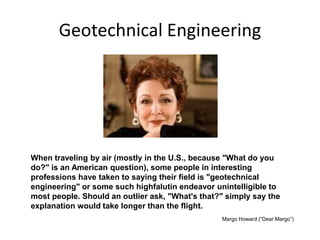Geotheta for Beginners
Geotheta for Beginners
Blog Article
The Best Guide To Geotheta
Table of ContentsExcitement About GeothetaThe smart Trick of Geotheta That Nobody is Talking AboutExamine This Report on GeothetaGeotheta Things To Know Before You Get This
They work together with civil designers, architectural designers, designers, and other experts to incorporate geotechnical considerations into the general task style and construction process. This calls for efficient team effort, sychronisation, and interaction to guarantee that the geotechnical facets line up with the project goals and satisfy regulative demands.Mining & Materials Design: Concepts of exploration, infiltration rates, and elements influencing the selection of drilling technique. Blasting methods in surface and below ground functions. Mechanical and continual techniques to fragmentation, consisting of longwall shearing and fullface boring.
Modelling of fragment and bit size distributions; comminution as a transfer feature. Comminution technology: squashing, grinding, dimension classification. Integrated evaluation of fragmentation and comminution procedures. Provided by: Mining & Materials Design.
9 Simple Techniques For Geotheta
Bachelor's level programs in civil, geotechnical, geological, and ecological engineering normally last four years and include basic education and learning training courses in English, social scientific research, and the humanities, as well as courses in sophisticated maths, structural geology, and fluid mineralogy. (https://dzone.com/users/5183482/geotheta.html)
Geotechnical engineering involves the analysis of the soil and rock conditions at a specific website, and their effects for the development of that site. As most structures count on the ground for assistance, it is without shock that a thorough understanding of the ground conditions, and the suitability of structure systems, are crucial to the long-lasting stability and performance of the building or framework.
Specialising in the investigation of geological formations and ground behaviour, geotechnical designers do clinical examinations and screening to comprehend the impact these geological developments might carry the layout and construction of building, civil and infrastructure jobs. This knowledge is crucial for the style and building and construction of buildings, roadways, tunnels, dams, bridges, and water and sewage systems.
The geotechnical team at Douglas Allies routinely seek advice from engineers, style engineers, programmers, and builders to make referrals on design and advancement proposals to guarantee that the constructed structures are appropriately developed for the ground problems. The layout of footing systems needs to think about the weight of the framework, the capacity of the ground to support that weight with each other with movement tolerances and effective construction.
How Geotheta can Save You Time, Stress, and Money.
This task is considerably simplified by the usage of our Douglas Map geospatial system that makes this details readily accessible in a simple to use web internet browser interface. A geotechnical designer will route the boring of boreholes and test pits to accumulate dirt and other examples, and additionally examine surface area functions and ground exposures to develop a geotechnical model of the subsurface problems.
Relying on the task kind and ground conditions experienced, lab screening might among various other points examine toughness, compressibility, sensitivity and/or permeability of dirt and rock examples. Hereafter data is accumulated and collated, the outcomes are used for a geotechnical design of the website, which is usually provided as areas across the website.

A geotechnical investigation naturally can just analyze the ground conditions at the areas pierced or dug deep into. Natural variants in dirt and rock problems can take place across a website and in between examination locations. It is for that reason excellent technique that the geotechnical designer be maintained throughout construction of the task to provide on-site verification that the ground conditions encountered follow the assumptions and recommendations offered in the geotechnical investigation report.
Some Known Details About Geotheta
Geotechnical designers utilize their thorough understanding of dirt and rock to analyze threat and fix troubles on diverse framework projectsGeotechnical engineering is a specialist branch of civil design which takes a look at the behaviour of planet materials and the application of soil and rock mechanics. Consulting Engineers. As a geotechnical engineer, you will certainly evaluate the physical, mechanical and chemical buildings of dirt and rock in order to develop foundations, keeping structures and earthworks
Geotechnical design is very closely linked to and overlaps with, both design geology and ground engineering - https://www.brownbook.net/business/52934980/geotheta/. It's possible to be experts in geotechnics or job for a geotechnical firm yet be referred to as a design geologist or a ground engineer. As a geotechnical engineer, you'll need to: build and maintain partnerships with customers and various other professionals associated with the site, throughout each projectmaintain safety and security criteria on site be conscious of expense ramifications when you make recommendationsstudy geological maps and airborne pictures from a series of sources and from various time periodsexamine building and construction plans to see how feasible they are based upon your understanding of the siteinvestigate dangers or geological hazards for the sitesearch for environmentally delicate attributes, such as land fill begin to establish valid and expository ground modelsplan field investigationsdrill and evaluate samples of bedrock, dirt, groundwater and added products monitor various other experts on sitesolve technical problems as they develop, such as unanticipated structures at drill sitesmonitor conditions throughout and after building to important link see to it frameworks are steady in the short and long termadding information accumulated on website to your first researchcreating geotechnical estimations, drawings, and two or three-dimensional computer designs translating the datamaking referrals concerning the proposed use the site

Report this page